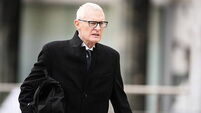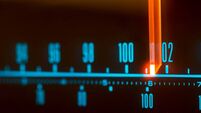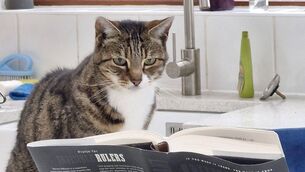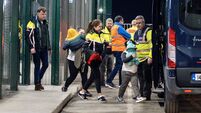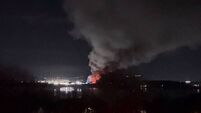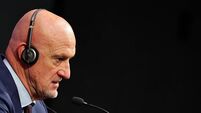Assumptions about women in religion show Mary is vital symbol

Today is the Feast of the Assumption all over the Christian world, a feast day first instituted by Emperor Maurice in 600 AD and bigged up by Pope Nicholas 1 around 850 AD to rival Christmas and Easter.
It honours the day a little more than 2,000 years ago on which Mary, the mother of God, was “assumed” bodily into heaven.
This bodily assumption has been a clear doctrine of the Catholic Church since Pope Pius X11 proclaimed it in 1950. Four years later he proclaimed Mary “Queen of Heaven.” I know several Marians getting the bus pass who would prefer if their name weren’t associated with the Marian year, 65 years ago.
A thornier issue as regards the Assumption, however, is the contradiction some see between Christ’s full humanity as a child of Mary and Mary’s evasion of bodily death and decay.
I am not interested in this question and I suspect you aren’t, either.
What interests me, instead, are the ancient origins of today’s feast as a harvest festival honouring the Great Mother.
That doesn’t mean discounting the importance of Mary.
Far from it. She is vital.
I grew up with a form of Protestantism which virtually expunged Mary from the Christian story but I have always needed the consolation and inspiration of Mother Mary.
As a feminist icon, she has her issues, not least the emphasis on her virginity. Having been conceived “immaculately” she then gave birth to the Child Jesus despite her protest, “How can that be as I know not a man?” Marina Warner whose thumping tome “Alone of all her sex: the myth and cult of the Virgin Mary” I read when first in search of Mary 30 years ago sheds a different light on this virginity, linking it to the virginity of Greek and Roman goddesses such as Artemis, Hippolyte, Diana and Parthenos, who were not so much pure as autonomous.
As Warner points out, Queen Elizabeth 1 was not called “the Virgin Queen” to indicate her chastity but to indicate instead that she could not be “subjugated or possessed”.
In a time when pregnancy was constant and childbirth, dangerous, it is perhaps less surprising that the image of the Virgin Mother of God would be attractive.
Let’s be clear, however: the image of the Virgin Mary has relentlessly presented women, throughout Christian history, with an image of womanhood to which they can’t possibly attain, impossibly pure and yet impossibly maternal.
That’s not been good for women but I don’t believe the same women would have been free from repression had the image of the Virgin not been there.
Though it is taken as a given in countries with secular or Protestant majorities that Catholic-majority countries are backward and conservative, Catholics are consistently more liberal towards homosexuality, for instance, than people of other religions in Pew and Gallop polls.
I believe the fact that both genders are represented in Catholic iconography encourages open-mindedness.
As Warner admits, “a goddess is better than no goddess at all.” She adds, “The Protestant religion is altogether too much like a gentlemen’s club to which the ladies are only admitted on special days.” There is no such thing as “the Protestant religion” but it’s true that all Protestant sects diversify themselves from Roman Catholicism and the Orthodox Church by banishing the Mother of God; I grew up surrounded by the hundreds of Virgins placed in grottoes during the Marian Year and was taught to regard them as alien, backward and almost dangerous.
The inherent “danger” was, of course, the power of the Virgin as the female face of God.

No, says every Christian denomination, God is God and his earthly mother is just a special saint.
What Catholicism and Orthodoxy acknowledge in the place they give the Virgin Mary, however, is our desperate need for female divinity. I don’t think that statement is inconsistent with Christianity.
Surely a more mature vision of God is as both male and female, even if He is always described to us as male in our sacred texts, written within the context of another social order?
Our need of a mother or a mother-figure is, I think, basic, and therefore it’s not surprising we need a Mother-God.
Many years ago when I was electrified by research by Michael Carrol at the University of Western Ontario which ran Marian apparitions through a computer programme and found them constantly appearing to girls at about puberty who had lost a mother or a mother figure (her elder sister in the case of Bernadette of Lourdes) in the previous eight weeks.
I think that was the point at which I stopped laughing at reported apparitions and accepted that most people who have a vision need that vision. I also began to hope that Ann Lovett had her baby and died under a statue of the Virgin Mary in 1984 because she was looking for comfort, not forgiveness.
The Virgin Mary mothers the motherless. Her image addresses a primal need. Of course she is a stereotype but she is probably no more powerful, no more forgiving, no more gentle and no more comforting than infants typically perceive their mothers to be.
Infants perceive their mother as their source, their world, their nourishment.
It's not surprising that the identification of the Earth as a Mother exists in most cultures and these Earth Mothers have, in our Christian culture, been both preserved and tamed through the image of the Virgin Mary.
Today is a special day at Marian shrines all over the country but I think especially of Lady’s Island in Co. Wexford where Masses will run daily until September 8th.
Driving past one night a few years ago I was riveted by the sight of a candlelit procession moving across the causeway to the dark island which was probably sacred to a female spiritual leader long before Christianity.
Mary is the protector of the seas, of course, the “stella maris”. I remember the emotion I felt when I walked the entire River Dodder and found her statue facing out to sea at Ringsend Church.
Today I will be with hundreds of pilgrims sailing out from Roonagh Pier in Co. Mayo, from Inishturk and Inishbofin and other points west, to Caher Island, six miles off the coast for Mass at the Oratory. The island is associated with St. Patrick and the pilgrimage completes the Reek Sunday ascent of Croagh Patrick.
But this is a pre-Christian sacred site and we are travelling on the Feast of the Assumption, under which the memory of an earlier Earth Goddess undoubtedly lies.
The Virgin Mary is our Demeter, goddess of the Harvest, and we need her today as much as ever.





